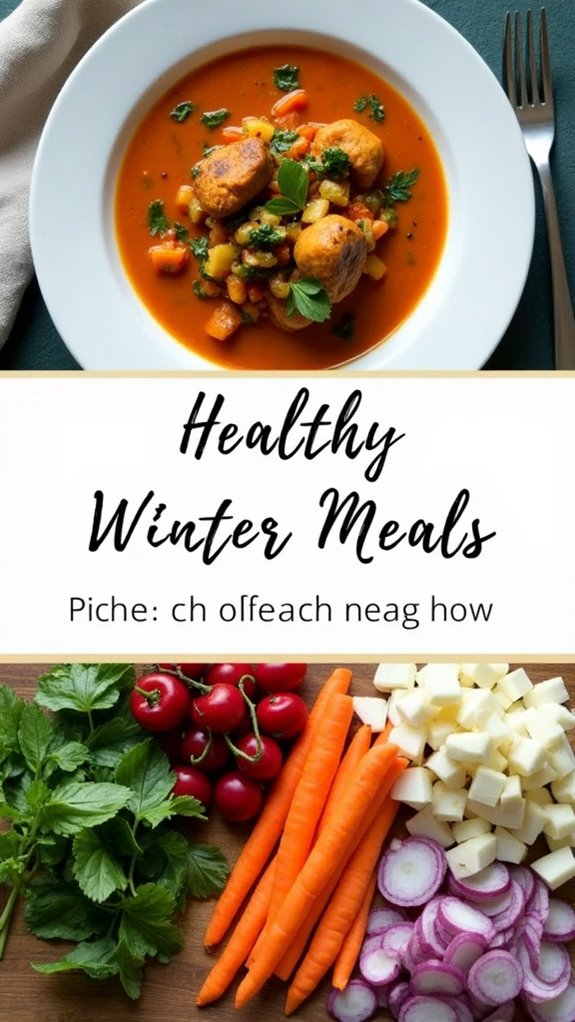Healthy Winter Meals
Healthy winter meals can feel like a warm hug on a chilly day. They’re packed with hearty ingredients that not only nourish your body but also keep you cozy during the cold months. By focusing on seasonal produce, you can enhance flavors while supporting local farmers. Curious about how to create these satisfying dishes? Let’s explore some delicious recipes and tips to make your winter meals both nutritious and enjoyable.
Why You’ll Love This Recipe
When you try this recipe, you’ll quickly see why it’s a favorite for healthy winter meals. Packed with nutritious ingredients, it warms you up while providing essential vitamins and minerals.
The combination of hearty vegetables, lean proteins, and whole grains guarantees you’re getting a balanced meal. Plus, it’s easy to prepare, making it perfect for busy weeknights.
You can customize it to fit your taste preferences, whether you like spicy flavors or milder options. The dish also stores well, so you can enjoy leftovers for lunch the next day.
Best of all, it keeps you feeling satisfied without weighing you down. You’ll find that this recipe not only nourishes your body but also fits seamlessly into your winter routine.
History
Healthy winter meals have a rich history that dates back to ancient times, as people sought ways to nourish themselves during the colder months.
Early civilizations relied on hearty ingredients like root vegetables, grains, and preserved meats to sustain them through harsh winters. They learned to cook meals slowly, allowing flavors to meld and creating comforting dishes.
In many cultures, winter meals became communal events, fostering connections and warmth. As time passed, cooking techniques evolved, but the essence of using seasonal ingredients remained.
Today, you can appreciate this tradition by incorporating wholesome foods into your winter meals. Understanding the history behind these dishes can inspire you to create meals that not only nourish your body but also connect you to past generations.
Recipe

Ingredients:
– 1 tablespoon olive oil
– 1 onion, diced
– 2 cloves garlic, minced
– 2 carrots, chopped
– 1 sweet potato, diced
– 1 zucchini, diced
– 1 bell pepper, diced
– 1 cup kale, chopped
– 1 cup quinoa, rinsed
– 4 cups vegetable broth
– 1 teaspoon dried thyme
– 1 teaspoon cumin
– Salt and pepper to taste
– Fresh parsley for garnish (optional)
Cooking Instructions:
- In a large pot, heat the olive oil over medium heat. Add the diced onion and sauté for about 5 minutes, until it becomes translucent.
Then, stir in the minced garlic and cook for an additional minute until fragrant.
-
Add the chopped carrots, sweet potato, zucchini, and bell pepper to the pot. Cook for about 5-7 minutes, stirring occasionally, until the vegetables start to soften.
-
Stir in the chopped kale, rinsed quinoa, vegetable broth, dried thyme, cumin, salt, and pepper. Bring the mixture to a boil, then reduce the heat to low and cover the pot.
-
Let the stew simmer for 20-25 minutes, or until the quinoa is cooked and the vegetables are tender.
If the stew is too thick, you can add a little more broth or water to reach your desired consistency.
- Once cooked, taste and adjust the seasoning if necessary. Serve hot, garnished with fresh parsley if desired.
For an extra touch, consider adding a splash of lemon juice or a dash of hot sauce before serving to brighten up the flavors.
This stew stores well in the fridge for up to five days, making it a perfect option for meal prep.
You can also freeze individual portions for quick and convenient meals later. Enjoy your warm, nutritious winter meal!
Final Thoughts
After enjoying a warm bowl of the hearty vegetable and quinoa stew, it’s important to reflect on how this meal fits into your winter cooking repertoire.
This dish not only warms you up on chilly days but also offers essential nutrients. Incorporating a variety of vegetables and whole grains can boost your health and energy levels during winter months.
Remember, meal prepping can save time during busy weeks. Consider making larger batches and freezing portions for quick access.
Additionally, don’t hesitate to experiment with spices and herbs to keep flavors exciting.
As you plan your winter meals, focus on balance and variety to maintain a healthy diet. Embrace these hearty recipes to nourish your body and soul throughout the season.
FAQ
What should you know about preparing healthy winter meals? First, focus on seasonal ingredients like root vegetables, greens, and hearty grains. These not only boost nutrition but also enhance flavor.
When planning meals, aim for balance—combine protein, healthy fats, and fiber. For example, a vegetable soup with beans and whole-grain bread makes a filling dish.
Don’t forget about spices! They add warmth and can improve health benefits.
Also, try batch cooking; it saves time and guarantees you have healthy options ready.
Lastly, stay hydrated. In winter, we often forget to drink enough water. Herbal teas can be a comforting way to stay hydrated and warm.
